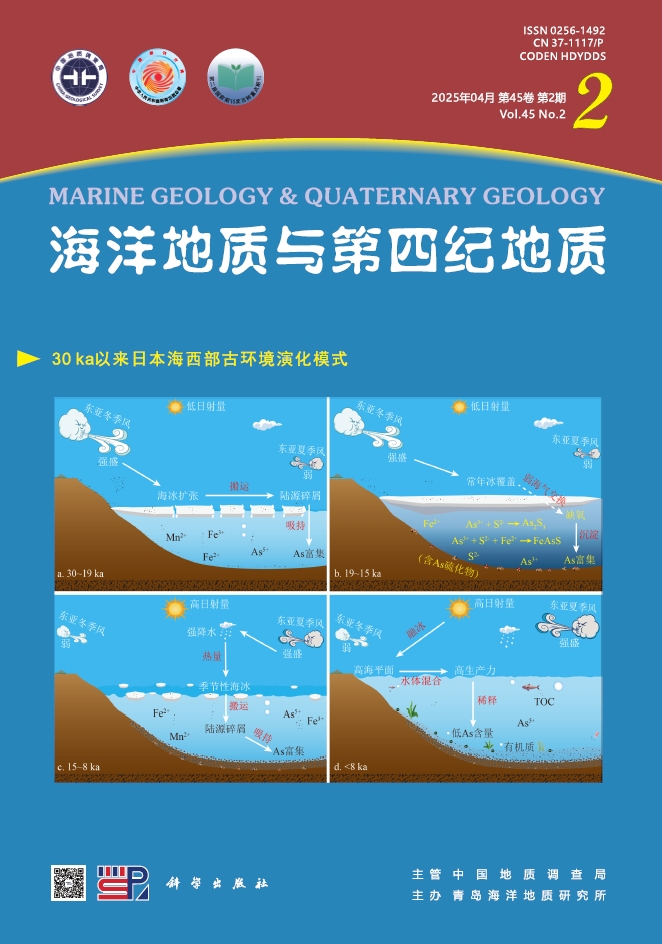| [1] |
Talley L Y, Pickard G L, Emery W J, et al. Descriptive Physical Oceanography:An Introduction[M]. sixth edition, Published by Elsevier Ltd. 2011:983.
Google Scholar
|
| [2] |
Der Zwaan V, Duijnstee G J, den Dulk I A P, et al. Benthic foraminifers:proxies or problems:A review of paleoecological concepts[J]. Earth Science Review, 1999, 46:213-236.
Google Scholar
|
| [3] |
Murray J W. The niche of benthic foraminifera, critical thresholds and proxies[J]. Marine Micropaleontology, 2001, 41:1-7.
Google Scholar
|
| [4] |
Saidova Kh M. Benthic Foraminifera of the World's Ocean[M]. Izdat. Nauka, Moscow, 1976.
Google Scholar
|
| [5] |
Kwiek P B, Ravelo A C. Pacific Ocean intermediate and deep water circulation during the Pliocene[J]. Palaeogeography, Palaeoclimatology, Palaeoecology, 1999, 154(3):191-217.
Google Scholar
|
| [6] |
McDougall K. Benthic foraminiferal response to the emergence of the Isthmus of Panama and coincident paleoceanographic changes[J]. Marine Micropaleontology, 1996, 28:133-169.
Google Scholar
|
| [7] |
Jian Z M, Wang L J. Late Quaternary benthic foraminifera and deep-water paleoceanography in the South China Sea[J]. Marine Micropaleontology, 1997, 32(4):127-154.
Google Scholar
|
| [8] |
陈萌莎,黄宝琦. 早第四纪西太平洋底栖有孔虫群与大洋深层水环流演化的关系[J].海洋地质与第四纪地质,2012, 32(4):97-105.
Google Scholar
[CHEN Mengsha, HUANG Baoqi. Evolution of Early Pleistocene deep water circulation in western Pacific evidence from benthic foraminifera[J]. Marine Geology and Quaternary Geology, 2012, 32(4):97-105.]
Google Scholar
|
| [9] |
Hess S, Kuhnt W. Benthic foraminifera abundance of ODP Site 184-1143[R]. 2005. doi:10.1594/PANGAEA.230243.
Google Scholar
|
| [10] |
黄宝琦,翦知湣,赵泉鸿,等.晚上新世以来南海北部深部水团演化[J]. 地球科学,2005,30(5):529-533.
Google Scholar
[HUANG Baoqi, JIAN Zhimin, ZHAO Quanhong, et al. Variations in deep-water masses from the northern South China Sea since the Late Pliocene[J]. Earth Science, 2005, 30(5):529-533.]
Google Scholar
|
| [11] |
杜江辉.早更新世西太平洋深层水环流的变化[D].北京大学硕士论文,2011:63.[DU Jianghui. Western Pacific Deep Water Circulation in Early Pleistocene, Master Thesis, 2011. PP63.]
Google Scholar
|
| [12] |
Clemens S C, Prell W L, Sun Y, et al. Southern Hemisphere forcing of Pliocene d18O and the evolution of Indo-Asian monsoons[J]. Paleoceanography, 2008,23:4210, doi:10.1029/2008PA001638.
Google Scholar
|
| [13] |
Venti N L, Billups K, Stable-isotope stratigraphy of the Pliocene-Pleistocene climate transition in the northwestern subtropical Pacific[J]. Palaeogeography, Palaeoclimatology, Palaeoecology, 2012, (54-65):326-328. doi:10.1016/j.palaeo.2012.02.001.
Google Scholar
|
| [14] |
Shackleton N J, Kennett J P. Late Cenozoic Oxygen and Carbon Isotopic Changes at DSDP Site 284:Implications for Glacial History of the Northern Hemisphere and Antarctic[M]. Initial reports of the Deep Sea Drilling Project, 1975:29.
Google Scholar
|
| [15] |
Lisiecki L E, Raymo M E. A Pliocene-Pleistocene stack of 57 globally distributed benthic δ18O records[J]. Paleoceanography,2005,20(1):DOI 10.1029/2004pa001071.
Google Scholar
|
| [16] |
Huang B, Jian Z, Wang P. Benthic foraminiferal fauna turnover at 2.1 Ma in the northern South China Sea[J]. Chinese Science Bulletin, 2007, 52(6):839-843.
Google Scholar
|
| [17] |
Raymo M E, Hodell D, Jansen E. Response of deep ocean circulation to initiation of northern hemisphere glaciation (3-2 MA)[J]. Paleoceanography, 1992, 7(5):645-672. doi:10.1029/92PA01609.
Google Scholar
|
| [18] |
Hodell D A, Venz-Curtis K A. Late Neogene history of deepwater ventilation in the Southern Ocean[J]. Geochemistry, Geophysics, Geosystems, 2006, 7(9):Q09001. doi:10.1029/2005GC001211.
Google Scholar
|
| [19] |
Harris S E. Data report:late Pliocene-Pleistocene carbon and oxygen stable isotopes from benthic foraminifers at Ocean Drilling Program Site 1123 in the southwest Pacific[C]//Proc. ODP, Sci. Results, 181, 2002:1-20. Ocean Drilling Program, College Station, TX. doi:10.2973/odp.proc.sr.181.203.
Google Scholar
|






 DownLoad:
DownLoad: